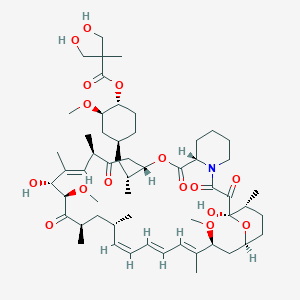Drug Information
Drug (ID: DG00177) and It's Reported Resistant Information
| Name |
Temsirolimus
|
||||
|---|---|---|---|---|---|
| Synonyms |
Torisel
Click to Show/Hide
|
||||
| Indication |
In total 1 Indication(s)
|
||||
| Structure |

|
||||
| Drug Resistance Disease(s) |
Disease(s) with Resistance Information Discovered by Cell Line Test for This Drug
(1 diseases)
[2]
|
||||
| Target | Serine/threonine-protein kinase mTOR (mTOR) | MTOR_HUMAN | [1] | ||
| Click to Show/Hide the Molecular Information and External Link(s) of This Drug | |||||
| Formula |
C56H87NO16
|
||||
| IsoSMILES |
C[C@@H]1CC[C@H]2C[C@@H](/C(=C/C=C/C=C/[C@H](C[C@H](C(=O)[C@@H]([C@@H](/C(=C/[C@H](C(=O)C[C@H](OC(=O)[C@@H]3CCCCN3C(=O)C(=O)[C@@]1(O2)O)[C@H](C)C[C@@H]4CC[C@H]([C@@H](C4)OC)OC(=O)C(C)(CO)CO)C)/C)O)OC)C)C)/C)OC
|
||||
| InChI |
1S/C56H87NO16/c1-33-17-13-12-14-18-34(2)45(68-9)29-41-22-20-39(7)56(67,73-41)51(63)52(64)57-24-16-15-19-42(57)53(65)71-46(30-43(60)35(3)26-38(6)49(62)50(70-11)48(61)37(5)25-33)36(4)27-40-21-23-44(47(28-40)69-10)72-54(66)55(8,31-58)32-59/h12-14,17-18,26,33,35-37,39-42,44-47,49-50,58-59,62,67H,15-16,19-25,27-32H2,1-11H3/b14-12+,17-13+,34-18+,38-26+/t33-,35-,36-,37-,39-,40+,41+,42+,44-,45+,46+,47-,49-,50+,56-/m1/s1
|
||||
| InChIKey |
CBPNZQVSJQDFBE-FUXHJELOSA-N
|
||||
| PubChem CID | |||||
| ChEBI ID | |||||
| TTD Drug ID | |||||
| VARIDT ID | |||||
| INTEDE ID | |||||
| DrugBank ID | |||||
Type(s) of Resistant Mechanism of This Drug
Drug Resistance Data Categorized by Their Corresponding Diseases
ICD-02: Benign/in-situ/malignant neoplasm
| Drug Resistance Data Categorized by Their Corresponding Mechanisms | ||||
|
|
||||
| Key Molecule: Growth arrest specific 5 (GAS5) | [2] | |||
| Molecule Alteration | Expression | Down-regulation |
||
| Resistant Disease | Mantle cell lymphoma [ICD-11: 2A85.0] | |||
| Experimental Note | Revealed Based on the Cell Line Data | |||
| Cell Pathway Regulation | Cell apoptosis | Inhibition | hsa04210 | |
| Cell proliferation | Activation | hsa05200 | ||
| mTOR signaling pathway | Regulation | hsa04150 | ||
| In Vitro Model | Z138 cells | Peripheral blood | Homo sapiens (Human) | CVCL_B077 |
| Jeko-1 cells | Blood | Homo sapiens (Human) | CVCL_1865 | |
| Experiment for Molecule Alteration |
RT-PCR | |||
| Experiment for Drug Resistance |
Nigrosin exclusion analysis | |||
| Mechanism Description | Small interfering RNAs (sirRNAs) targeting GAS5 protect the cell viability and proliferation of jeko-1 and z-138 cells from the inhibitory effects of mTOR inhibitors result in rapamycin resistance. | |||
| Drug Sensitivity Data Categorized by Their Corresponding Mechanisms | ||||
|
|
||||
| Key Molecule: Growth arrest specific 5 (GAS5) | [1] | |||
| Molecule Alteration | Expression | Up-regulation |
||
| Sensitive Disease | Prostate cancer [ICD-11: 2C82.0] | |||
| Experimental Note | Revealed Based on the Cell Line Data | |||
| Cell Pathway Regulation | Cell proliferation | Inhibition | hsa05200 | |
| In Vitro Model | DU-145 cells | Prostate | Homo sapiens (Human) | CVCL_0105 |
| LNCaP cells | Prostate | Homo sapiens (Human) | CVCL_0395 | |
| PC3 cells | Prostate | Homo sapiens (Human) | CVCL_0035 | |
| 22RV1 cells | Prostate | Homo sapiens (Human) | CVCL_1045 | |
| PNT2C2 cells | Prostate | Homo sapiens (Human) | CVCL_4889 | |
| Experiment for Molecule Alteration |
qRT-PCR | |||
| Experiment for Drug Resistance |
GAS5 assay; MTS assay | |||
| Mechanism Description | First generation mTORC1, combined mTORC1/mTORC2 and dual PI3k/mTOR inhibitors all increased cellular GAS5 levels and inhibited culture growth in androgen-dependent (LNCaP) and androgen-sensitive (22Rv1) cell lines, but not in androgen-independent (PC-3 and DU 145) cell lines. The latter exhibited low endogenous GAS5 expression, and GAS5 silencing in LNCaP and 22Rv1 cells decreased the sensitivity to mTOR inhibitors, whereas transfection of GAS5 LncRNA sensitized PC-3 and DU 145 cells to these agents. | |||
References
If you find any error in data or bug in web service, please kindly report it to Dr. Sun and Dr. Zhang.
